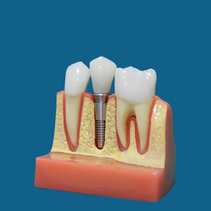ORAL PATHOLOGY
Oral Pathology is a type of dentistry centered around the diagnosis and treatment of oral diseases, including oral cancer. The inside of the mouth is normally lined with a special type of skin (mucosa) that is smooth and coral pink in color. Any alteration in this appearance could be a warning sign for oral disease. The most serious of these diseases is oral cancer.
TMJ TOUR CHANNEL
Types of Oral Pathology

Cold sores, canker sores and oral ulcers
Tongue lesions / abnormalities
including Candidiasis
(Thrush)
Oral lesions/tumors
including pre-cancer and cancer
Gum and soft tissue inflammation
Periodontal disease
(gum disease)
Cysts and tumors of the jaw bones
Oral cancer is the most serious type of oral pathology.
An estimated 53,000 new cases of oral cancer arise every year in the United States.
Signs of oral pathology can appear on the lips, cheeks, palate, gum tissue around the teeth, tongue, face, and/or neck. Pain isn't always present with these conditions and is not commonly associated with oral cancer. However, if you experience unexplained facial and/or oral pain, it could be a warning sign of oral cancer. It is important to see a doctor immediately if you notice any of these symptoms.
Common Symptoms
Sores that are not healing
Abnormal Lumps / Tissue Thickening
White or red patches in mouth
Pain or difficulty swallowing
Numbness in jaw, lips, or face
Bleeding in mouth or gums
Significant weight loss
Significant changes in bite


Ways to Avoid Oral Cancer
Avoid alcohol & tobacco products

Eat a healthy, well balanced diet
Limit high sun exposure
Practice good oral hygiene
Screening and early detection
Maintain healthy lifestyle
Oral cancer has an 80% to 90% survival rate when found in the early stages of development.
- American Association of Oral and Maxillofacial Surgeons
EARLY DETECTION IS KEY
We would recommend performing an oral cancer self-examination monthly. Remember that your mouth is one of your body’s most important warning systems. Please contact us so we can assist you with any questions or concerns.
6 Self-Examination Steps
Remove any dentures
Look and feel inside lips & front gums
Tilt head back to check roof of mouth
Pull cheek out to check back of gums
Stick out tongue to check top & bottom
Feel for lumps on both sides of neck and lower jaw

We prioritize your comfort and safety throughout every step of your experience. We strive to exceed your expectations at every visit, ensuring you receive the highest quality of care tailored to your individual needs. Trust our team to restore your smile with precision, expertise, and a genuine commitment to your oral health journey.
-
Pre-SurgeryBefore any treatment commences, patients undergo a thorough examination, including x-rays and MRI's to assess their oral health and determine the best course of action. Dr. Gallagher works closely with your dental team throughout the treatment process to ensure optimal results. Prior to surgery, patients receive extensive preoperative education to understand what to expect and how to manage post-surgery care effectively. Multiple consultations are conducted to address any concerns and ensure patients feel confident about the procedure. Patients are encouraged to ask any questions they may have, as the dental team is dedicated to providing support and guidance throughout the process. When you are fully informed about the aspects of your care, you and your dental team can make the decision to proceed with treatment together.
-
ProcedureThe surgery itself can last between 1 to 4 hours and is typically performed in a hospital or outpatient setting. It is rare for patients to stay overnight following orthognathic surgery. During the procedure, braces remain on the teeth to assist in controlling jaw position while the patient heals. Both the orthodontist and Dr. Gallagher work together to move the teeth and adjust the upper and/or lower jaws as needed.
-
RecoveryFollowing surgery, patients can expect to be off work or school for approximately 10 to 12 days. They will also be placed on a non-chew diet for a minimum of 3 months, during which only soft foods that do not require chewing are permitted. Weekly appointments are necessary during the first month after surgery to monitor healing progress and make any adjustments as needed. We highly encourage every patient follow the post-surgery instructions provided by Dr. Gallagher's office.













